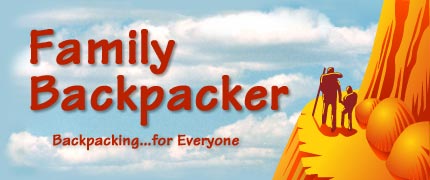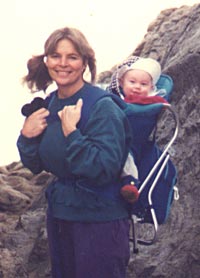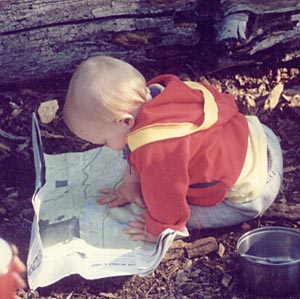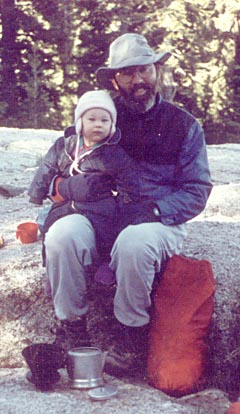

General Family Backpacker Tips
There are a lot of good reasons to take your child backpacking. Chief among them is to help your child discover a love and respect for the outdoors. To accomplish this goal, in short, you have to do whatever is necessary to make sure the trip is FUN. At the conclusion of the trip, your child should be able to say, "Let's do it again!"
General Tips
Planning
Checklist
 The House on Your Back
The House on Your Back
 Food
Food
 Clothing
Clothing
Getting There
On the Trail
Around Camp
DonÕts
Hiking Out
 Be sure to take a camera. Take lots of pictures. Email some to us for inclusion in our gallery.
Be sure to take a camera. Take lots of pictures. Email some to us for inclusion in our gallery.
To see a real-life example of a trip plan, check out this Cub Scout site. It details the planning for a very successful backpack trip in summer 2000 that included seven families: 12 adults and ten kids, ages seven to 16.
- Every child is different, even those in the same age group. Get to know your child's limits.
- Make the outdoors a part of your everyday life. It's hard to instill an appreciation in young people if the only hiking they do is on the big trip once a year. Try to do day hikes of varying lengths at least once a month throughout the year, rain or shine.
- Plan, plan, plan. Even on a simple overnighter you don't want to be caught without a flashlight.
- Make room in your plans for the stuff you need to do before you leave your house. The Fun Factor goes way down if you try to gather together tents and cookwear on the morning you're supposed to be leaving.
- Bring along the best map youu can find of the area you're visiting. There's a special joy that comes from teaching a child how to read a map.
- Weight is all-important. Remove food items from their packaging, seal it in Zip-Loc bags, and leave the packaging behind. Shop for the smallest, lightest items you can find. Share. Some items (like tent and water filter) can be shared between two or more people.
- Your child should prepare their own pack as much as possible.
- Don't obsess about planning. It's supposed to be fun.
- Remember the backpacker's basic rule: When in doubt, leave it out.
- Have a relaxed attitude about food. Your kid won't die from eating nothing but hot dogs and marshmallows for a few days.
CHECKLIST: THE HOUSE ON YOUR BACK
Think of your pack as a house, with many rooms.
 KITCHEN
KITCHEN
food (see below)
matches
fuel
stove
cook pans
knife/fork/spoon
bowl
cup
bio soap
scrubber
trash bag
water filter
water bottle
paper towels
BATHROOM
toothbrush
tooth paste
comb
toilet paper
shovel
BEDROOM
tent
ground cloth
rain fly
sleeping bag
pillow
pad
flashlight
LIVING ROOM
camera
book
musical instrument
cards/games
PORCH
sunscreen
insect repellent
hat
sunglasses
map
star chart
handkerchief
first aid kit
GARAGE
fishing rod
fishing reel
lures/tackle
folding knife
whistle
camera
film
ditty bag
binoculars
string/rope
nature guides
extra stuff sack
CLOSET
clothing (see below)
Freeze-dried foods have come a long way over the years. They are light, easy to prepare and clean up, tasty - and usually fairly expensive. If it's your first trip, try some. Otherwise, you can probably do fine with more generic foods
Here's a sample menu for a trip of four nights:
Sunday:
Dinner: Noodles parmesan (from package) with broccoli; salad (cucumber, carrot, celery, zucchini with dressing) Dessert: Smores
Monday:
Breakfast: Cream of wheat (instant), granola, milk (instant); fruit (apple); coffee.
Lunch: Instant soup, cheese, fig bars, fruit.
Dinner: Basmati rice with shrimp (canned) and butter (squeeze); broccoli. Dessert: pudding.
Tuesday:
Breakfast: Cream of wheat (instant), granola, milk (instant); fruit (apple); coffee.
Lunch: Instant soup, cheese, fig bars, fruit.
Dinner: Campfire foil packs - potato, onion, carrots, butter... and trout! Dessert: Smores.
Wednesday:
Breakfast: Cream of wheat (instant), granola, milk (instant); fruit (apple); coffee.
Lunch: Instant soup, cheese, fig bars, fruit.
Dinner: Noodle casserole with tuna; salad. Dessert: pudding.
Thursday:
Breakfast: Cream of wheat (instant), granola, milk (instant); fruit (apple); coffee.
The food list for the above menu would look like this:
2 packages noodle dinners, put (with cut-out instructions) into zip bags 1 cup basmati rice
2 potatoes
1 head of broccoli (stems removed)
1 cucumber
2 carrots
1 onion
2 stems celery
1 zucchini
small plastic container salad dressing
1 can baby shrimp
1 can tuna
small container margarine
whole wheat fig bars
3 apples
3 oranges
mozzarella cheese
6 packages instant soup
8 packs instant cream of wheat
granola
6 individual containers pudding
aluminum foil
coffee filters
4 shrink-wrapped coffee packs
instant hot chocolate packs
instant milk
marshmallows
chocalate bars
graham crackers
trail mix
a few surprises
Know (as much as possible) the weather, and plan your clothing accordingly. It always might rain, so pack a poncho, or use a space blanket (which doubles as a ground cloth).
First-day hiking: Wear shorts, t-shirt, underwear, socks, boots, hat. Have access to a hanky.
In a single stuff sack:
3 t-shirts
4 pair underwear
4 pair socks
2 pair shorts
swim suit
small towel
sweat pants
sweat shirt
long-sleave flannel shirt
windbreaker or light jacket
nightwear: polypro top and bottom
extra stuff sack for dirty clothes
I'll also pack sandals for wear around camp.
- When it was just you, you could drive to the mountains listening to music or engaged in conversation. With a child, you'll need to plan for entertainment aids.
- Look into making reservations at a motel near the trailhead. Getting a good nights sleep, and having a shower and hot breakfast before settinf out can be good for everybody. You might even think about starying there after hiking out.
- Start early and don't hike too far, or too much at a stretch. Take frequent rest/snack breaks.
- Make sure your child's equipment fits right, especially shoes. Ask frequently about hot spots on the feet, and take care of them before they become blisters.
- Don't make them carry too much weight. Anticipate taking some of their load if the fun-factor starts getting thin.
- If your child starts to flag, get them to talk or play word games. If they can think about something besides their discomfort, they'll get there before they know it.
- On the trail, everybody should drink lots of water, and often.
- Don't stay out too long. Take just enough food and supplies.
- Stay on the trail; no cutting switchbacks.
- Wait at trail junctions for the rest of your group.
- The quieter you are, the more wildlife you'll see.
- Uphill hikers and livestock have the right of way. Move to the uphill side of the trail and wait for them to pass.
- Every child who can walk should have a whistle on a lanyard around their neck.
- Try to be as quiet as possible. Have fun, and do lots of yells (wait til you hear the echoes!), but no unnecessary screaming or other loud noises. Remember, there may be other people in the area, and their for solitude is important. It would be unfortunate if you ruined someone else's vacation.
- Fires: Use an existing fire ring, if possible. Make a single campfire of moderate size, lit only in the evening. Use only downed, dead wood. Woodgatherers may have to scavenge over a large area. No horseplay around the fire. No burning plastic or trash (other than small amounts of plain paper). No cutting or damaging of live wood.
- Dump cooking water, waste and dishwater at least 100 feet from creek or lake. Use only biodegradable soap.
- Burn paper waste, but compact plastic and metal trash and place it in the camp trash bags to pack out.
- Do not litter. This includes orange peels, apple cores and the like.
- Establish a washing area at least 100 feet from any water source and restore the area to a natural looking state when you are ready to leave. Use a large container to carry water away from stream or lake shore for use.
- Food Storage:
Always store garbage, cosmetics, toothpaste, soap, or anything with any odor with food. Store items properly at all times except when preparing what is needed for your meal. Leave empty packs on the ground with all pockets and flaps open. Store water bottles out of sight with cooking gear.
In bear country, bear resistant food storage canisters are usually the only effective portable means of food storage. These portable containers are the most effective way for backpackers to store food in wilderness. Each plastic canister weighs less than 3 pounds, fits in a full-sized backpack, and is capable of holding up to 3 to 5 days worth of food for one person. Canisters are available for rent for $3.00 a trip at most permit stations and many stores near bear country. Canisters can be returned at any rental location.
The Counter Balance Method. Although the counter-balance method of food storage is not illegal, it is not recommended due to its lack of effectiveness and the damage that is caused to trees by persistant bears. If you choose to store your food using this technique, consider it only a delaying tactic. Be prepared to actively defend your food and repeatedly scare bears out of your camp through the night. Without this negative reinforcement, bears will figure out a way to get your counter-balanced food - some bears will go so far as to literally chew the branch off the tree to get at food bags.
- Water:
Giardiasis is an intestinal disease caused by Giardia lamblia, a water-borne protozoan. Giardia is carried by humans and some domestic and wild animals that may contaminate lakes and streams. All water or melted snow must be treated by boiling for at least 5 minutes, using an iodine-based purifier, or using a Giardia-rated water filter. Associated symptoms include chronic diarrhea, abdominal cramps, bloating, fatigue, and loss of weight. Treatment by a physician is necessary to kill the organisms.
Drinking any untreated water in the wilderness will make you sick. Water may be treated three ways: 1) Filtration: the preferred method, kids should feel free to pump water through a filter any time they want to; 2) Boiling 3-5 minutes; 3) Use an iodine based chemical purifier.
- Human waste:
Number One - Pee off the trail, at least 100 feet from any water source.
Number Two - Find a secluded place 100 feet or more from any water source and from camp. Dig a small hole 6 to 8 inches deep, and position yourself over it. Ready, aim, fire. Use a small amount of TP. Carry a Zip-Loc bag and put used toilet paper in it (you will pack it out - or, use wax paper bags and burn it in a campfire ceremony at night). Fill in the hole and return it to as natural a state as possible. Do not just plant a rock on it and leave.
- The wilderness is sensitive, and must be treated with respect. Try to minimize your impact.
- ... put anything in the lake or streams; even "biodegradable" soap pollutes.
- ... build rock walls, bough beds, new fire rings, trenches, or campsite "improvements."
- ... pick wildflowers. This is a misdemeanor in some states.
- ... feed the wild animals.
- Breaking camp - The evening before the final night, organize everything for the hike out.
- After breakfast on the last morning, carefully pack up everything. Leave the camp site in a condition that is cleaner than we found it. Before you put your pack on your back, look around thoroughly for every human-made item.
- Plan it so that on hike-out day, the only food you're carrying is stuff you're going to eat on the trail, and the only clothes you're carrying are filthy.
